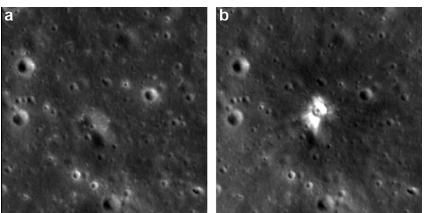Modelling Lunar Impact Flashes from Molten Ejecta
- 1Freie Universität Berlin, Geological Sciences, Planetary Sciences and Remote Sensing, Berlin, Germany (paige.rice@fu-berlin.de)
- 2Museum für Naturkunde Berlin, Leibniz Institute for Evolution and Biodiversity Science, Berlin, Germany
Introduction:
Lunar impact flashes have been observed from Earth since 1999 [1]. To date, over 600 impact flashes have been detected by individuals as well as multiple observation campaigns [2], including the NASA Lunar Impact Monitoring Program, the MIDAS project, and the NELIOTA project. The record of flashes has been analysed statistically to estimate the current near-Earth meteorite flux and size distribution [3], though the results of such estimates rely on some assumptions about the relationship between the radiative energy of the flashes and impactor velocity and kinetic energy.
Luminous efficiency, the fraction of impactor kinetic energy that is transformed into light emission during the impact process, is a poorly constrained value. Common estimates range over three orders of magnitude, from 10-2 to 10-4 [4]. Recent modelling work produced a detailed model of the radiant process in the impact debris cloud and fit well to the observed flash using calculated impactor properties [5]. Their work builds on previous studies considering the physics of the radiant process, indicating that vaporized material in the instant of impact cannot provide enough thermal radiance to account for impact flash magnitude, and most of the light from impact flashes is created by thermal radiance of droplets of melted ejecta [1]. However, they did not fit their model to the observed diameter and depth of an associated crater.
Method:
We seek to improve the constraints on luminous efficiency by modelling simplified analogues of observed impact flashes with known associated craters. Here, we use the iSALE-Dellen shock physics code [6,7,8] to model the 17 March 2013 lunar impact flash and crater [Fig. 1], adjusting the impact parameters to best replicate the known factors of the impact and match the resultant crater size. Target porosity, modelled by the ε-α-porosity compaction model [8,9], is set at a homogeneous 42% and a vertical impact in a 2D cylindrical model is used for computational efficiency. We use the Drucker-Prager strength model and the ANEOS equation of state to model the lunar regolith. Then, we determine the volume of melted ejecta produced in each impact as a proxy for radiance, and vary velocity-mass balance and target porosity parameters to study the effect on ejected melt volume. Crater data permitting, we will also study additional, recently identified flash-crater pairs [10,11,12].

Figure 1: Crater identified with 17 March 2013 impact flash. a: before, b: after. [13]
Results:
We show some preliminary results of our first study models in the plot below. Peak pressure on target material is plotted (in Pa x1e10). Material above the black curve is ejected as the model proceeds. All material is shown in position at t=0. The resolution of this model (10 CPPR) is not sufficient for a detailed analysis of peak pressure and melt volume; 40 CPPR resolution will yield a better result, reducing uncertainty to <10% [14]. Critical shock pressure for melt production in regolith at 42% porosity is estimated at no higher than 24 GPa [14]. Our preliminary model shows only a small sliver of overlap between melt volume and ejecta volume, much lower than the 20-30% of melt ejected in [15], suggesting a low luminous efficiency in this impact.
Figure 2: Peak pressure on target material for modelled 17 March 2013 impact. Material above the black curve is ejected. Material above 24 GPa peak pressure is assumed melted.
Conclusion:
Further study of the details of thermal radiance of the ejected melt will be left to a future study, enabling a connection from impact parameters to luminous efficiency via melt volume. This work could also be expanded through use of 3D models with realistic replication of the estimated impact angles of known impact flash craters, as well as more detailed, layered target rock properties.
References
[1] Yanagisawa, Masahisa et al. (2002), Icarus 159 (1), pp. 31–38. DOI: 10.1006/icar.2002.6931.
[2] Sheward, D. et al. (2024), MNRAS 529 (4), pp. 3828–3837. DOI: 10.1093/mnras/stad2707.
[3] Avdellidou, Chrysa et al. (2021), Planetary and Space Science 200, p. 105201. DOI: 10.1016/j.pss.2021.105201.
[4] Ortiz, J. L. et al. (2000), Nature 405 (6789), pp. 921–923. DOI: 10.1038/35016015.
[5] King, Patrick K. et al. (2022), 16th Hypervelocity Impact Symposium. DOI: 10.1115/HVIS2022-28.
[6] Amsden, A. et al. (1980), LANL, LA8095:101.
[7] Collins, G.S. et al. (2004), Meteoritics & Planetary Science 39:217–231. DOI: 10.1111/j.1945-5100.2004.tb00337.x.
[8] Wünnemann, K. et al. (2006), Icarus 180, pp. 514-527. DOI: 10.1016/j.icarus.2005.10.013.
[9] Collins, G. et al. (2011), Int. J. Imp. Eng., 38:434-439. DOI: 10.1016/j.ijimpeng.2010.10.013,
[10] Sheward, Daniel et al. (2021), Europlanet Science Congress 2021. DOI: 10.5194/epsc2021-590.
[11] Sheward, D. et al. (2022), MNRAS 514 (3), pp. 4320–4328. DOI: 10.1093/mnras/stac1495.
[12] Sheward, Daniel et al. (2024), EGU General Assembly 2024, Abstract EGU24-1216. DOI: 10.5194/egusphere-egu24-1216.
[13] Robinson, Mark S. et al. (2015), Icarus 252, pp. 229–235. DOI: 10.1016/j.icarus.2015.01.019.
[14] Liu, T. et al. (2022), JGR Planets 127 (8), Article e2022JE007264, e2022JE007264. DOI: 10.1029/2022JE007264.
[15] Luther, R. et al. (2017), 48th Annual Lunar and Planetary Science Conference (1964), p. 3012. Bibcode: 2017LPI....48.3012L.
How to cite: Rice, P., Luther, R., and Wünnemann, K.: Modelling Lunar Impact Flashes from Molten Ejecta, Europlanet Science Congress 2024, Berlin, Germany, 8–13 Sep 2024, EPSC2024-560, https://doi.org/10.5194/epsc2024-560, 2024.